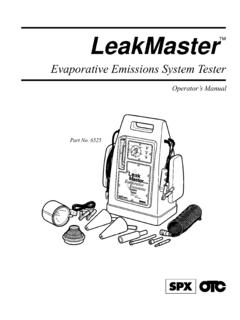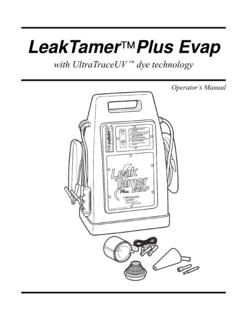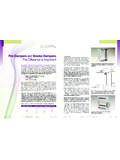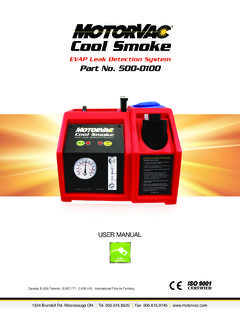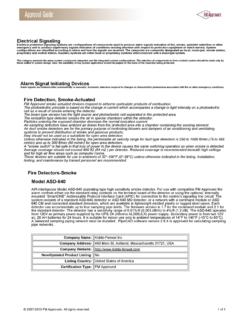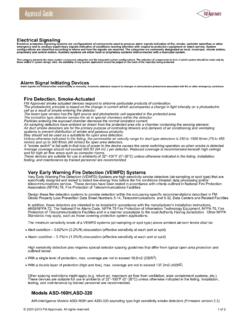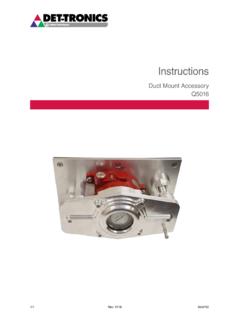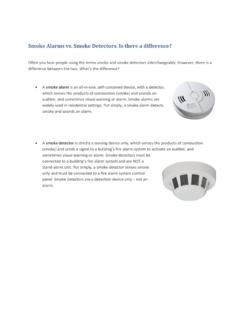Transcription of Fiinndd EEVVAAPP LLeeaakkss iinn 66 EEaassyy SStteeppss
1 FFiinndd EEVVAAPP LLeeaakkss iinn 66 EEaassyy SStteeppss CCoonnnneecctt ttoo tthhee CCoonnnneecctt ttoo vveehhiiccllee ss EEVVAAPP CClloossee vveenntt PPuusshh tthhee RReemmoottee VVeerriiffyy iiff EEVVAAPP ssyysstteemm hhaass aa FFiinndd LLeeaakkss bbyy vviieewwiinngg eexxiittiinngg ssmmookkee &&//oorr vviieewwiinngg tthhee uullttrraavviioolleett--aaccttiivvaattee dd fflluuoorreesscceenntt ddyyee ddeeppoossiitteedd aatt tthhee lleeaakk((ss)).. 6 Look for the exiting smoke or UltraTraceUV dye deposited at the exact location of the leak(s) Close Vent Solenoid Fail Pass 12354 What do you do if there is NO service port? To Charcoal Canister /To Charcoal Canister /1. Find the Vapor Management Valve. 2. Locate and identify the line going to the charcoal canister from the Vapor Management Valve. 3. Insert the supply line into the line that you just removed from the Vapor Management Valve as shown below.
2 Vapor Management ValvePurge Valve Front Door Vapor Management ValvePurge Valve Front Door - Have you ever had your scan tool NOT be able to close an EVAP vent solenoid? First of all, it s NOT a fault of the scan tool. Some car companies don t even have the ability to do this task! We are going to use a voltmeter to handle this new way of closing the vent solenoid. (Can be applied to most models*) 1. Disconnect the plug-in on the EVAP vent solenoid. 2. Turn Ignition key ON with engine NOT running. 3. Use a voltmeter to test which one is (pos) & (neg) 4. REMEMBER WHICH ONE IS WHICH! Put to known good groundVent Solenoid - 5. Reconnect the connector to the solenoid. 6. Rotate the selector to the mA position. 7. Move the RED lead to the mA position. Now the voltmeter is an amp meter and will be a direct current path to ground the vent solenoid. 8. Back probe the negative side of the vent solenoid with the red lead. 9. With the Ignition key ON, engine NOT running, touch the black lead to the negative post of the vehicles battery.
3 When you touch the black lead to the battery (with key On) it will energize the solenoid - Closing it .*Additional procedures may be required on some models Battery of vehicle being 370mATesting the LDP system 1. Go to your information system to get positive I-D on the three wires going to the LDP. (Leak Detection Pump) 2. Energize LDP solenoid. With a hand vacuum pump, apply vacuum to the Vacuum Port on LDP. 3. Monitor the Sense Wire with voltmeter. With the LDP powered up, the Sense Wire will have BAT voltage available. While the LDP solenoid is energized, apply vacuum until the Sense Wire BAT voltage is gone. Apply vacuum to hose at intake manifold if system has a 3-way valve. LDP must be able to hold vacuum above 5" or vent valve will not stay closed. Closing just the LDP vent valve only 1. Remove vacuum hose from the LDP solenoid next to three wire connector. 2. Connect a hand vacuum pump to the vacuum port next to the 3-wire connector.
4 3. Apply 12 of vacuum and vent valve will close. If vacuum bleeds down to or below 5 in 60 seconds, the LDP pump will be unable to hold the vent valve closed. Go back to the LDP test above. **(Once voltage is gone the vent valve is closed) Leave the 3-wire connector connected to the LDP CClliimmaattee CCoonnttrrooll LLeeaakkss iinn 66 EEaassyy SStteeppss 1. Connect to the battery. 2. Insert smoke supply hose into vacuum line after check valve. 3. Press remote button. 4. Change position on selector. 5. Check flow meter (No Flow No Leak) 6. Look for smoke or UltraTraceUV dye. If there is flow there is a leak SSeeeeiinngg IIss BBeelliieevviinngg 123456 55 EEaassyy SStteeppss ttoo FFiinndd VVaaccuuuumm LLeeaakkss CCoonnnneecctt ttoo tthhee CCoonnnneecctt SSmmookkee SSuuppppllyy LLiinnee ttoo DDiirreecctt MMaanniiffoolldd VVaaccuuuumm BBlloocckk ooffff IInnttaakkee MMaanniiffoolldd ((YYeellllooww CCaapp)).
5 PPuusshh tthhee RReemmoottee UUssee aa BBrriigghhtt HHaallooggeenn LLiigghhtt aanndd LLooookk ffoorr SSmmookkee EExxiittiinngg tthhee LLeeaakk((ss)),, oorr uussee aa UUVV lliigghhtt aanndd llooookk ffoorr tthhee ddyyee IItt WWoorrkkss oonn AALLLL YYeeaarrss,, MMaakkeess aanndd MMooddeellss12345 SSeeeeiinngg IIss BBeelliieevviinngg VVeenntt VVaallvvee,, RReeaarr CCoovveerr,, AAxxllee && Pinion Seals In 5 Easy CCoonnnneecctt ttoo tthhee IInnsseerrtt EExxhhaauusstt CCoonnee iinnttoo DDiiffffeerreennttiiaall && IInnsseerrtt SSmmookkee SSuuppppllyy iinnttoo EExxhhaauusstt PPuusshh tthhee RReemmoottee AAfftteerr SSmmookkee CCoommeess OOuutt ooff tthhee VVeenntt,, PPiinncchh ooffff tthhee VVeenntt HHoossee ttoo AAllllooww PPrreessssuurree ttoo UUssee aa BBrriigghhtt LLiigghhtt aanndd LLooookk ffoorr SSmmookkee EExxiittiinngg tthhee LLeeaakk((ss)).
6 UUssiinngg DDiiaaggnnoossttiicc SSmmookkee ffoorr LLeeaakk DDeetteeccttiioonn !!12345 FFiinndd EExxhhaauusstt LLeeaakkss iinn 44 EEaassyy SStteeppss SSeeeeiinngg IIss BBeelliieevviinngg CCoonnnneecctt ttoo tthhee IInnsseerrtt EExxhhaauusstt CCoonnee iinnttoo TTaaiill PPiippee && TThheenn IInnsseerrtt SSmmookkee SSuuppppllyy HHoossee iinnttoo EExxhhaauusstt PPuusshh tthhee RReemmoottee UUssee aa BBrriigghhtt LLiigghhtt aanndd LLooookk ffoorr SSmmookkee EExxiittiinngg tthhee LLeeaakk((ss)),, oorr uussee UUVV lliigghhtt aanndd llooookk ffoorr ddyyee ddeeppoossiittss aatt tthhee lleeaakk((ss)).. 12344 WWIINNDD && WWAATTEERR LLeeaakkss TTuurrnn oonn vveehhiiccllee ss HHVVAACC bblloowweerr ((sseett ttoo FFrreesshh AAiirr )).. ((TThhiiss ccrreeaatteess ppoossiittiivvee ccaabbiinn pprreessssuurree)) CCoonnnneecctt uunniitt ss ssmmookkee ddiiffffuusseerr ttoo ssuuppppllyy LLaayy ssmmookkee ppaatthh aalloonngg (Note.)
7 The UltraTraceUV dye in the smoke will not be deposited on components when used in this manner and is not harmful in any way) NNoottiiccee ssmmookkee ppaatthh ddiissttuurrbbaannccee aatt ppooiinntt ooff Same car in area with no leak FFiinndd OOiill LLeeaakkss iinn 66 EEaassyy SStteeppss CCoonnnneecctt ttoo tthhee IInnsseerrtt SSmmookkee SSuuppppllyy HHoossee iinnttoo DDiippssttiicckk TTuubbee SSeeccuurreellyy RReemmoovvee OOiill FFiilllleerr ccaapp ttoo PPuurrggee SSyysstteemm && BBlloocckk ooffff AALLLL EExxiittss ((PPCCVV )) ttoo aallllooww PPrreessssuurree ttoo UUssee aa BBrriigghhtt LLiigghhtt aanndd LLooookk ffoorr SSmmookkee EExxiittiinngg tthhee LLeeaakk((ss)).. LLooookk ffoorr BBuubbbblliinngg aanndd//oorr DDiiaaggnnoossttiicc SSmmookkee ffoorr LLeeaakk DDeetteeccttiioonn !!OOIILL LLEEAAKK TTEECCHH TTIIPP This unit can identify oil leaks in 3 different ways: ( 1 ) Smoke ( 2 ) Bubbling of oil with little or no smoke ( 3 ) Dripping of oil, no smoke at all.
8 THIS TEST CAN ONLY BE DONE AS DESCRIBED IN THIS TECH TIP Attach the power leads to the battery. Red to (+) and Black to chassis ground. Remove oil dipstick, put a short piece of hose over the tube and insert smoke supply hose. Block or plug PCV, Air breather and Intake YOU MUST BE ABLE TO BUILD PRESSURE IN SYSTEM BEING TESTED The unit only builds psi, which will not be high enough to cause any damage to the system being tested. Remove the oil filler cap. Push the button on the remote starter cable. Wait until the fresh air is purged and the smoke is coming out like shown in picture. Next, reinstall oil filler cap. This will allow pressure to build. If pressure is not allowed to build the test will NOT work. If you skip this step, you risk not finding the small leaks, which could result in misdiagnosis. Now that you have reached max pressure, start looking for the three different ways that leaks appear. ( 1 ) Smoke ( 2 ) Bubbling of oil with little or no smoke ( 3 ) Dripping of oil, no smoke at all YOU CAN SEE THE SMOKE COMING FROM THE CORNER OF THE OIL PAN/TIMING COVER 1 SMOKING 2 BUBBLING 3 DRIPPING Using Diagnostic Smoke ffoorr LLeeaakk DDeetteeccttiioonn!
9 ! OOBBDD IIII MMaassss AAiirrfflloowwCCooddeeTTeecchh TTiippIn this tech tip we will show you the FIRST thing to do on a MAF sensor code. The test car is a 3/97 S70 turbo Volvo with only 41k on the clock. Symptoms: Tip-in hesitation, Surge, Rolling idle, and best of all, the famous Yellow Light. Attach the units power leads to the battery. Red to (+) and Black to Chassis Ground. Attach the supply hose to a direct vacuum manifold source. Insert the proper yellow cap plug into the air induction inlet hose. Place the cap between mass airflow sensor and the air induction hose shown in the picture. Remember it is important to block the intake so it can build pressure. Push the remote control button. Don t forget that leaks can be found in areas that you least expect. Take the time to look. Get any bright white halogen light. At this point, shine the halogen light, in the area described below.
10 Also don t forget about using your UV light and looking for the UltraTraceUV dye. Drivers side rear of engine, down by the turbo, under the waist gate actuator, where it is almost impossible to see or to get to. You may find a number of leaks but any one can cause the problem. You can see a small puff of smoke in the picture to the right (red arrow). This leak is big enough to cause that all famous yellow light to come on. There is no Scan tool, Gas or Engine Analyzer, Lab Scope, or Voltmeter on the planet that can pinpoint this leak like this unit can. (In 3 minutes or less). Smoke is the visual answer! The story here is, before you break out your arsenal of equipment, that we all know can t pinpoint the leak, take the 3min. to test it with diagnostic smoke to find the leak(s) and repair. Now, what will YOU do first? MAF CapsLeak EEGGRR TTEECCHH TTIIPP Some EGR valves (Like Ford) have what I call a metered leak.
